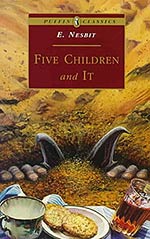
![]() Rhondak101
Rhondak101
6/26/2014
![]()
E. Nesbit is the pen name of Edith Bland. Edith Bland (1858-1924) was a very interesting woman. She was a co-founder of the English Fabian Society, meaning that she was an early communist. She was a friend of fellow Fabian and playwright George Bernard Shaw. She and her husband and his mistress, Alice Hoatson, had a relationship that we can only guess about. Edith adopted the two children that her husband had with Hoatson, and Hoatson continued to live with them as a housekeeper.
Given her personal and political life, I expected to see a glimpse of Bland's politics in E. Nesbit's Five Children and It. Yet, I was surprised to find that the children exist in a fairly rigid class structure. The parents, generally absent, belong to the upper-middle class, and the servants raise the children. While the lower classes are not portrayed as stupid, they are continually defined by their work. For example, the baker's boy is called jut that. Therefore, her books are not much different than other young adult writers of her time and afterwards.
The tone and structure of Five Children and It reminds me of C. S. Lewis' Narnia books. In the novel, two brothers—Robert and Cyril--and two sisters—Anthea and Jane--along with their 2-year-old brother whom they call Lamb, discover a sand-fairy called a Psammead. (Why are these children in charge of the baby and taking him all over the English countryside one must wonder.) The Psammead claims that he has been napping since the days of the dinosaurs and resents being awakened by such a group of rude and boisterous children. They learn that the Psammead can grant wishes. However, he tells them that granting wishes is hard work and it takes him a while to recover, so he bargains that he will only grant one wish per day that they must share between them. Also, each wish ends at sunset.
Most of the wishes go horribly awry because the children are not specific enough in their requests (and, of course, because the Psammead is a trickster figure). What is interesting about the plot is the children learn from their mistakes and begin to make wishes that limit the power of wishes that go wrong. Sometimes these adaptations are helpful and other times they create new problems. The thinking and the planning of the children certainly kept the novel's plot from becoming stale.
This book was enjoyable. There are two more in this series that I plan to read. She has several more children's books (including two more series). Most of them are currently available at Gutenberg or at other free sites. Unfortunately, most of her adult novels are out of print and unavailable. Her ghost stories often appear in anthologies, and I just added an anthology of her horror to WWE. For those wanting to know more about E. Nesbit and her works, take a look at this 1969 New York Review of Books article written by Gore Vidal.